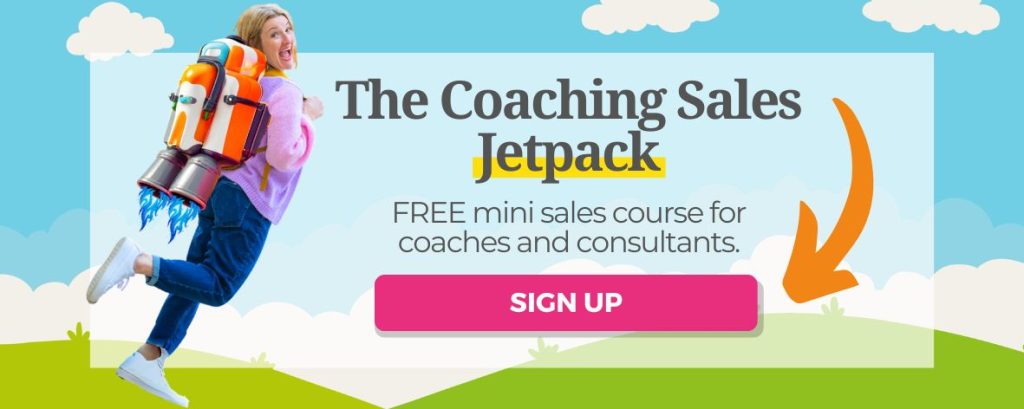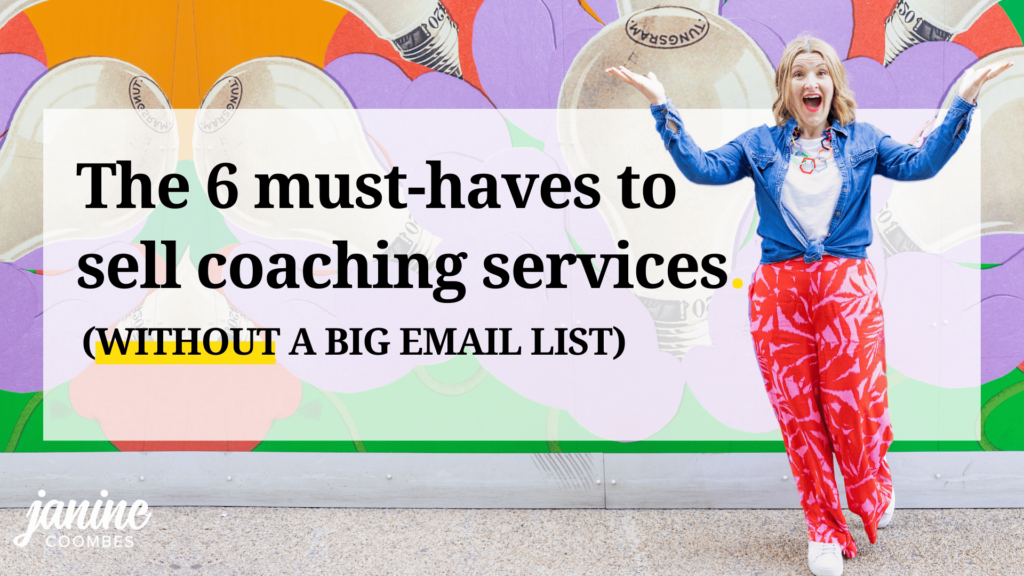I often work with people on creating a coaching offer that attracts their favourite types clients.
But a frequent sticking point is when the client in question doesn’t yet have that big-time momentum.
They don’t have a bulging email list. They don’t have their own podcast or video channel. In short, they don’t yet have a large, warm audience who are scrambling to buy what they’ve got to sell.
If this sounds like you, rest assured you can still sell successfully.
And, unless you have a nice nest egg to eat into, you can’t wait until you’ve built your audience before you start selling – you just have to get cracking now!
I’ve built up this list of six must-haves to sell without an email list, over the past few years of working with my clients.
Here they are, I’ll then go into each one in more detail:
- An ‘ideal customer’ that has the money to pay you
- A helpful set of beliefs
- An offer you know people actually want
- Focus
- A list of all your marketing touchpoints
- Lots of energy
N.B. For anyone reading this thinking ‘but Janine, building an email list should be of the utmost priority because selling to your email list is easier than anything you’re about to say!‘
I say YES, you’re right. But it’s really hard when you’re working with a small or non-existent team to do all the things at the same time.
In an ideal world we would be getting visible, list building, nurturing and selling all at the same time. And the established coach-shaped-businesses are doing that- but it takes time.
So I stand by my advice here, if you need to cash in sooner rather than later, get out there and see who’s ready to work with you now and see if you can tick off these six points.
1. An ‘ideal customer’ that has the money to pay you
This sounds bleedin’ obvious, doesn’t it! But I hear this surprisingly often:
‘The problem is that my ideal customer doesn’t have any money’.
If you find yourself saying this, ask yourself; are you trying to grow a successful business or are you trying to set up a charity?
I’m not being facetious; I’m asking you to get clear on your motives. If you want to create a charity, you can do that!
But if you’re building a business, then you need to make money.
To make money, you need to sell.
Who will buy from you?
People who actually have the money to pay you!
If you want to run a business and help people who can’t afford you there are ways you can do this, for instance:
- Give people free access to your courses who fit certain criteria
- Set aside a proportion of your working week to do pro bono work
- Award scholarships or part scholarships
- Create something helpful but low priced or free that these people in need can use, but that won’t take up any of your precious time on an ongoing basis.
But the truth is that most people don’t value free stuff. If they haven’t made the mental shift to part with the cash, they’re unlikely to put the effort in or value your work.
And what would the consequences of all this public-spirited work be? You’d need to earn even more money from the people who are paying you.
2. A helpful set of beliefs
If you struggle to sell in any way shape or form, there are probably some unhelpful beliefs lurking in that noggin of yours.
But instead of talking about negative thoughts, let’s have a look at the positive ones:
The belief that you’re running a business to make money
I’m assuming, if you’re still reading this, that this is where you are now.
Can we therefore agree that the need to make money is the main purpose of a running a business?
Yes, you also want to help people. Yes, you want to make an impact in the world. And yes, if you’re like me, you decided not to work for the man because you wanted more freedom in your life.
But the definition of running business has profit at its core.
The more money you make the more people you can help.
The more money you make, the more freedom you’ll have in your life.
The belief that you can help people
Do you have a strong belief in what you can do for people?
This is tricky for people who haven’t long set up their business and haven’t yet got armfuls of glorious testimonials singing their praises.
But it can also strike years into running your business.
If you feel yourself doubting your abilities, try this exercise; list 15 reasons why you’re the best person to help your ideal client with their problem. N.B. keep it in the context of what you want to sell!
Why 15? Because the first 5 are easy. The next 5 are trickier. And the final 5 will involve wracking your brain and digging down deep into the recesses of your tender mind. The last few responses are likely to be the best.
The belief that you would buy this offer
Be honest, if you were in your ideal customer’s shoes, would you buy this offer that you’re trying to sell?
If not, then you have some work to do. Either on the offer itself or in the way you’re talking about it.
If deep down you wouldn’t buy this thing yourself, how can you expect to be an effective salesperson for your business?
Yes, there are salespeople who manage to sell stuff they don’t believe in, but they’re douchebags and I don’t like them.
The belief that selling is serving
If you’re a human being living on planet earth you’ve probably had some bad experiences with being sold to.
These happenings seep into our belief system and then when it’s our turn to sell we recoil; ‘Erk, I don’t want to be a salesy sleazebag!’
But selling in and of itself is not sleazy. It’s the way business is done.
One of the most helpful things anyone ever told me about selling was that ‘selling is serving’.
You have something that can help people.
They won’t know about it unless you tell them and ask them if they’re interested!
There are ways to sell that are annoying and might feel horrible and at odds with your ethics- automated DMs anyone?
But there are so many more ways to make offers to people that will fit in with your values and that you can learn to feel good about.
The belief that your service is worth the money
The pressure to put your prices up is real.
I see so many bigwig influencers flippantly telling people to double their prices or ‘stick a zero on the end’.
While I absolutely believe that you should charge based on the amazing value you deliver (about 50% of my clients need to put their prices up), I also believe that you need to feel good about what you’re charging.
And if your prices aren’t high enough and you’re still feeling yucky about asking people for the dosh, we have a problem.
I’ve gradually put my prices up over the years as I’ve grown in confidence.
Yes, I know more now and I’m better at what I do because I’ve practiced more, but one of the biggest breakthroughs in my money mindset has been investing in my business.
The first time I worked with a coach who was more than £500 per month, it was a stretch. It felt like a ridiculous amount, but I believed in her and I believed in myself. By the end of the year, I was charging more than £500 a month for my biggest one-to-one marketing coaching package and I had more clients than ever.
I’m happy to sell my services and to charge what I do because I truly believe that my clients’ investment will pay back. If I don’t then I don’t make the offer.
The moral of the story is; set a price for your service that you feel completely comfortable with and root yourself in the knowledge that it’s worth it.
Don’t overcharge for the sake of it.
But if self-doubt comes a knockin’, invite it in for a chat and work out what’s at centre of it so you can deal with it head on.
Read more about pricing and raising your prices in my blog The top 6 FAQs about charging more for your services. And Why you shouldn’t charge your worth when pricing coaching services.
You can also get free access to my mini sales course The Coaching Sales Jetpack by clicking here or on the graphic below.

3. An offer you know people actually want
You’d be surprised how few people stop to think about this!
In fact, I’ve done it myself.
It’s so easy to get wrapped up with how good YOU think your service is; how jam packed full of value it is.
But if your prospective clients don’t see it that way, they’re not going to buy.
End of.
This is a whole topic of its own so I’ve written a blog called Why your coaching offer is the key to earning more.
And a free step-by-step guide on how to make sure your service offer will definitely sell.
4. Focus
Don’t groan! I know everyone’s always banging on about focus, but it’s an important point. Concentrating your time and energy on one this will always yield better results.
Selling one thing to one type of people will always cut through better.
Do you see Unilever trying to sell Ben and Jerry’s ice cream on their Dove adverts?
Do you see Amy Porterfield mentioning her other range of offers during her Webinars That Convert launches?
So don’t be tempted to widen the appeal of your service offerings until it becomes like watered down porridge. No one will want them.
Can we agree then? If you’re looking to sell like a firecracker, focus on:
- One client type
- One of their problems
- One offer
You might be thinking ‘is she talking about niching here..?’ or ‘why isn’t she mentioning niching?’
The reason is that I’m not saying that you have to stick with one client, one problem one offer. You can have as many offers as you want!
Just start by making sure your main bread and butter offer is compelling for one client type and one problem.
This isn’t niching, this is just common sense!
Read more about this approach in Why you DON’T have to niche (but what you do need to do instead).
5. A list of all your marketing touchpoints
As you’ve probably gathered, I didn’t write this blog for people with massive, red hot audiences.
If you’re reading this, I’m going to assume that you haven’t set up some slick Facebook ad fuelled funnel, you haven’t got a massive email list and you haven’t got tens of thousands of daily website visitors yet. (Do you ever want that..?)
Let me reassure you that those kinds of marketing systems and audience numbers take years to build up. They’ll come if you want that for your business.
But for now you have to use what you’ve got. And you might have more opportunities than you think.
It’s time to leverage ALL of your marketing touchpoints.
Write them ALL down.
List out:
- All the social media channels you use
- Your own content e.g. your website, your blog, podcast, video channel, email list, lead magnets and nurture sequences
- All the memberships and Facebook groups you’re in
- The networks you’re a part of
- All of your business mates who have complimentary services
- People who’ve had a discovery call with you in the last year
- And all the people who’ve worked with you in the past who might want this offer of yours
- Even friends and family who might know someone who needs a coach of your description
By the end you should have quite a long list.
Now you can go through and update all those touchpoints with details about your offer:
- Change all your headlines and bios to talk about your offer
- Email your list more times than you’re comfortable about it
- DM your clients, friends, family and colleagues for referrals
- Put shout outs in the groups that you’re allowed to
- Post about it every day on your social media and your own content channels
- If you’re asked to introduce yourself at an online event, mention your offer
Make your calls to action clear, directive, and easy to follow.
The vibe we want here is that everyone who knows you needs to know be what you’re selling at the moment.
Which means you’ll need…
6. Bags of energy
All this work; putting your offer out there, telling the people that matter what you have for them and yes… selling, it takes energy. All the energy you can muster in fact.
A few years ago I was struggling with getting sales in. I was quietly doing my thing, hoping that my ideal clients would notice me. Writing non-controversial social media posts and not actually telling people what I was selling.
I went on a launch course, the main benefit of which was accountability. And the knowledge that to make more sales you have to actually, well, sell!
Suddenly it all made sense. It was a comfort zone thing. I wasn’t used to selling. I had never sold before. But to make my business a success I had to get over myself and sell like my business depended on it! (Because it does.)
If you’re not used to selling, this kind of effort takes guts.
You’re going to feel like you’re boring people. You’re going to feel that inner resistance to ‘not be too salesy’. You’re going to notice other people on social media slagging off people for selling too much.
But what’s more important?
How much money you’re earning and what that means for your life and that beautiful butterfly effect that it’ll have on the rest of your world?
Or what a few nincompoops are saying on social media? Who are probably jealous because someone else has got the balls to put themselves out there and actually make something of themselves.
If you’re up for the challenge earmark at least two weeks in your diary to go for it hell for leather!
But before you do, do check that your offer makes sense. Have a read about why your coaching offer is the key to earning more (which includes a cautionary tale) here.
What you need to do next to sell your offer
How did you fare? Did you manage to tick of all six must-haves that’ll enable you to sell your service without a big email list?
If not then I have a few ways I can help.
- If you’ve already got something you want to sell, check out my free mini sales course for coaches called The Coaching Sales Jetpack. Click here to get free access.
- If you want a step by step way to make sure your service offer will definitely sell, click here for a free guide (this one’s a blog).
- Or if you’re a seasoned coach-shaped-person who’s looking to earn more without slogging your guts out, apply for The Freedom Giver. For full details click here.


